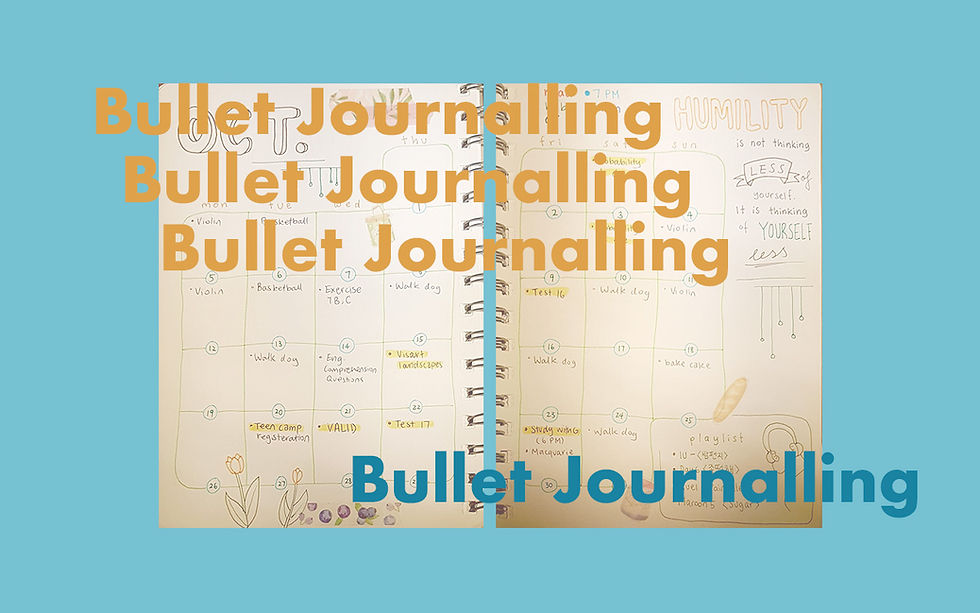Bullet Journalling with Celine Park
- The Ham
- Feb 3, 2021
- 4 min read
Updated: Feb 6, 2021

Celine Park walks us through her bullet journal process.
I came across this whole bullet journaling thing when I saw a video by a YouTuber called ‘AmandaRachLee’. At the time, I was desperately looking for a hobby for myself, because of my increasing addiction to YouTube. I believed that it would be much more productive and healthier for me to spend time on something fun instead of watching YouTube for the whole day, feeling like you’ve got nothing done, feeling useless, and going to sleep with some hope that you might be a better person tomorrow, only to fail again and repeating that routine over and over - you know what I’m talking about, right? So when I encountered bullet journalling, it was a perfect chance to start a hobby.
But it wasn’t the easiest thing I expected. I didn’t have any of the stationery or washi tapes that the bullet journaling YouTubers had. Just in case you’re struggling with this too, I’ll give some little tips:
GET THE $2.80 HIGHLIGHTERS FROM DAISO
There’s a high possibility that you’re going to do some calligraphy - unless you have your own style, which is perfecting fine - and the calligraphy pens from Officeworks or most of the shops I’ve been to are crazy expensive. So if you have just started, these highlighters are not only cheap but incredibly easy to do calligraphy with! Just watch some tutorials on how to write calligraphy with highlighters, and you’re good to go.
GATHER YOUR STICKERS
There are many cheap cute stickers in any stationery shop or even online, but these make your page look less empty and much more interesting.
START WITH WHAT YOU HAVE
I know I’ve set to get the Daiso highlighters, but other than that, just use your own stationery. You don’t NEED to have all those Muji pens. I think it’s more important to just start.

This is my title page. You write the month and decorate with some patterns around it. Feel free to decorate as much or less as you wish.

On the next page, I like to write down the goals I have for that particular month. Make sure it’s not too hard or broad. Try to make it something reasonable and simple. You can use symbols like triangles, circles, or arrows to indicate where you are at on completing that goal.
After that is the monthly calendar. Typically, there would be a quote, along with things like playlists, etc. Some people prefer to do them on a new page. Many people like to make separate spreads on habit trackers and mood trackers, but I didn’t do them regularly, so I just put them in different coloured dots, and marked them on the box of that day when I completed them. But this month I totally forgot about it.
This is how my weekly spreads look like. I have a to-do list, usually from the most important to least important. Next to that, I have a section for what I need to get done for each day.
If you have big amounts of work or study to do on a particular day, try this spreadsheet. The top part is pretty straightforward. Below is a table for writing the subject and tasks you need to complete. There is a column on the right to mark where you are up to by the end of the day. The key to this spread is on the right. It’s a grid and each square represents 10 minutes. The hour is written on the left of the grid. For every 10 minutes you study, you can highlight it. It is very effective to colour code each task so that you can see how much time you’ve spent on each task. Afterward, write the total number of hours you spent studying and write it at the top.

This is optional, but if you want to have a regular daily plan, this is a great way to organise your day.

This page is personally for me, but if you’re someone who wants to improve your vocabulary, you might want to try this out. Whenever you come across a word you don’t know, write it down on this page and search up the definition. Come back to it every week or so, and I’ll guarantee you, you’re English is going to be so much better.
This is just my style of doing bullet journaling, but there are countless other ways too. Check out some on YouTube. The basic order goes like this:
Title Page
Quote Page
Monthly Calendar
Playlist
Mood Tracker
Habit Tracker
Income & Expenditure
Weekly Spreads
‘One sentence a Day’ Page (writing one sentence anything - a summary of your day, quote, etc.)
Take out any that you don’t like and add some of your own ideas. Be creative!
I want to conclude this article by saying, a hobby is not just an option, but a necessity, if you want to feel more productive. It’s very important because these small hobbies may contribute to your future career or help you find a passion. So from today, try to cut down on those Youtube and social media, and start finding something more adventurous and interesting like me!











Comments